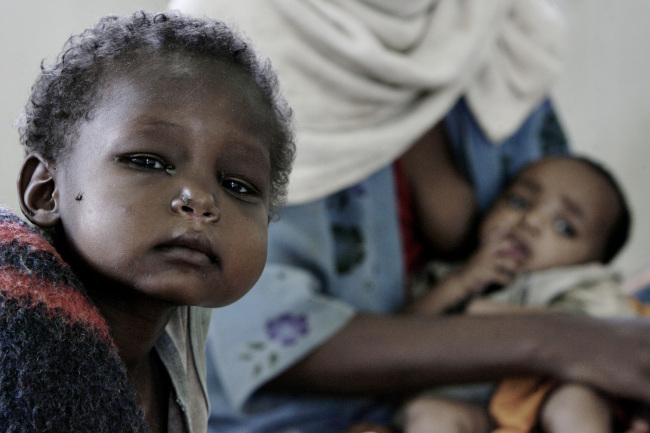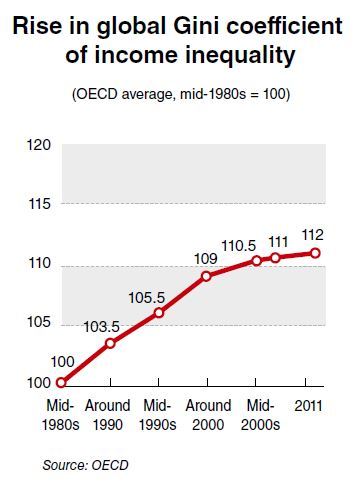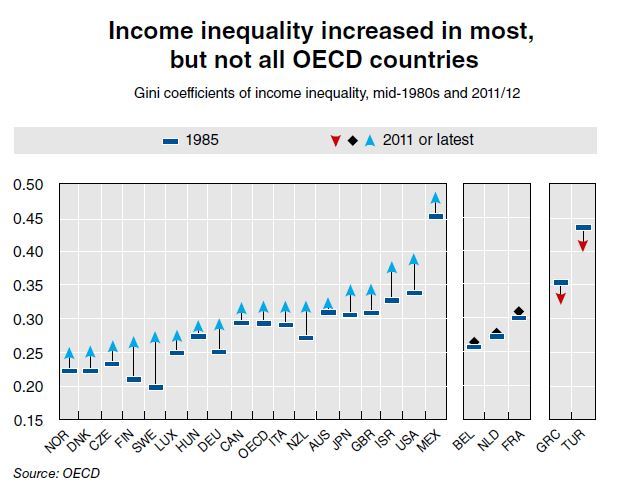This is the second in a series of articles on the prospects for the world economy in 2015 ― Ed.
The New Year is significant when it comes to the issue of sustainable economic growth and the promises made by world leaders 14 years ago that have not been fully kept.
World leaders, in adopting the United Nations Millennium Declaration in 2000, pledged to create a more equitable world by 2015. However, today, more than ever before, it seems that the wealthiest individuals have become wealthier while the relative situation of people living in poverty has improved little.
Disparities in education, health and other dimensions of human development still remain large despite marked progress in reducing the gaps. Various social groups suffer disproportionately from income poverty and inadequate access to quality services and, generally, disparities between these groups and the rest of the population have increased over time.
 |
A boy sits on a mattress at a feeding center in Damota Pulassa, Wolayta, Ethiopia. (Bloomberg) |
The implications of rising inequality for social and economic development are many. There is growing evidence and recognition of the powerful and corrosive effects of inequality on economic growth, poverty reduction, social and economic stability, and socially sustainable development.
The many adverse consequences of inequality affect the well-being not only of those at the bottom of the income distribution, but also those at the top. Specifically, inequality leads to a less stable, less efficient economic system that stifles economic growth and the participation of all members of society in the labor market.
According to a new report by the OECD, the situation is so bad now that global income inequality has returned to levels recorded in the 1820s ― when the Industrial Revolution produced sizable wealth gaps between the rich and poor.

The study uses historical data from eight world regions to examine 10 individual dimensions of well-being, tracking them over time and space, then pulls them together in a new composite indicator. The dimensions covered reflect a broad range of material and nonmaterial aspects: per capita GDP, real wages, educational attainment, life expectancy, height, personal security, political institutions, environmental quality, income inequality and gender inequality.
It reveals that great strides have been made in some areas, such as literacy, life expectancy and gender inequality, but while income inequality, as measured by pretax household income among individuals within a country, fell between the end of the 19th century until around 1970, it began to rise markedly at that point, perhaps in response to globalization.
Another OECD report suggests that reducing income inequality would boost economic growth. It found that countries where income inequality is decreasing grow faster than those with rising inequality.

“The single biggest impact on growth is the widening gap between the lower middle class and poor households compared to the rest of society. Education is the key: A lack of investment in education by the poor is the main factor behind inequality hurting growth.”
Rising inequality is estimated to have hold back growth in Mexico and New Zealand by more than 10 percentage points over the past two decades up to the Great Recession. In Italy, the United Kingdom and the United States, the cumulative growth rate would have been 6-9 percentage points higher had income disparities not widened, and inequality also reduced growth in Sweden, Finland and Norway, although at low levels. On the other hand, greater equality helped increase GDP per capita in Spain, France and Ireland prior to the crisis.
The impact of inequality on growth stems from the gap between the bottom 40 percent and
the rest of society, not just the poorest 10 percent. Anti-poverty programs will not be enough. Cash transfers and increasing access to public services, such as high-quality education, training and health care, are an essential social investment to create greater equality of opportunities in the long run.
The report also found no evidence that redistributive policies, such as taxes and social benefits, harm economic growth, provided these policies are designed, targeted and implemented well.
So is the situation really that bad?
Over the past 14 years, since the adoption of the Millennium Development Goals, the U.N. has stated that there has been important progress, with some targets already having been met well ahead of the 2015 deadline.
The MDGs are the world’s time-bound and quantified targets for addressing extreme poverty in its many dimensions ― income poverty, hunger, disease, lack of adequate shelter and exclusion ― while promoting gender equality, education and environmental sustainability. They are also basic human rights ― the rights of each person on the planet to health, education, shelter and security.
They are eight goals that all 191 U.N. member states have agreed to try to achieve by the year 2015: eradicating extreme poverty and hunger; universal primary education; promoting gender equality; reducing child mortality; improving maternal health; combating HIV/AIDS, malaria and other diseases; ensuring environmental sustainability; and developing a global partnership for development.
The 2014 MDG report notes that several targets have been met. According to it, the world has reduced extreme poverty by half, efforts in the fight against malaria and tuberculosis have shown results, access to an improved drinking water source became a reality for 2.3 billion people, disparities in primary school enrolment between boys and girls are being eliminated in all developing regions and the political participation of women has continued to increase. It also states that development assistance rebounded, the trading system stayed favorable for developing countries and their debt burdens remained low.
Having said that, while claiming that substantial progress has been made in most areas, it also agrees that much more effort is needed to reach the set targets.
Major trends that threaten environmental sustainability continue, also, more efforts are also needed to decrease chronic undernutrition among young children, reduce maternal mortality and improve sanitation. None of these goals can be achieved in the last year left for the MDGs.

Continued progress toward the goals in the remaining year is therefore essential to providing a solid foundation for the post-2015 development agenda.
The opportunities that 2015 presents for bringing the countries and people of the world together to decide and embark on new pathways forward are historic and unprecedented. These decisions will determine the global course of action to end poverty, promote prosperity and well-being for all, protect the environment and address climate change.
The actions made this year are expected to result in new sustainable development goals to follow the eight MDGs. This post-2015 development agenda is expected to tackle many issues, including ending poverty and hunger, improving health and education, making cities more sustainable, combating climate change, and protecting oceans and forests.
Governments are in the midst of negotiating, and civil society, young people, businesses and others are also having their say in this global conversation. World leaders are expected to adopt the agenda at the Special Summit on Sustainable Development in New York in September 2015.
Hopefully, there will be speedier progress in 2015.
By Ram Garikipati (
ram@heraldcorp.com)











